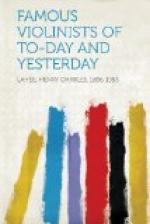Paganini created the difficulties which he performed. He had a style of his own, and was most successful in playing his own compositions. In Paris, when, out of respect to the Parisians, he played a concerto by Rode, and one by Kreutzer, he scarcely rose above mediocrity, and he was well aware of his failure. He adopted the ideas of his predecessors, resuscitated forgotten effects and added to them, and the chief features of his performance were, the diversity of tones produced, the different methods of tuning his instrument, the frequent employment of double and single harmonics, the simultaneous use of pizzicato and bow passages, the use of double and triple notes, the various staccati, and a wonderful facility for executing wide intervals with unerring accuracy, together with a great variety of styles of bowing. The quality of tone which he produced was clear and pure, but not excessively full, and, according to Fetis, he was a master of technique and phrasing rather than a pathetic player,—there was no tenderness in his accents.
It is said that Baillot used to hide his face when Paganini played a pizzicato with the left hand, harmonics, or a passage in staccato. Dancla, in his recollections, says: “I had noticed in Paganini his large, dry hand, of an astonishing elasticity; his fingers long and pointed, which enabled him to make enormous stretches, and double and triple extensions, with the utmost facility. The double and triple harmonics, the successions of harmonics in thirds and sixths, so difficult for small hands, owing to the stretch they require, were to him as child’s play. When playing an accentuated pizzicato with the left hand, while the melody was played by the hand of the bow, the fourth finger pinched the string with prodigious power even when the other three fingers were placed.”
There are anecdotes told of Paganini’s artistic contests with rival violinists, chief among whom were Lafont and Lipinski, both of whom he eclipsed, and of his playing a concerto in manuscript at sight, with the music upside down on the rack.
Of his appearance we are told, in an account of a concert in London: “A tall, haggard figure, with long, black hair, strangely falling down to his shoulders, slid forward like a spectral apparition. There was something awful, unearthly in that countenance; but his play! our pen seems involuntarily to evade the difficult task of giving utterance to sensations which are beyond the reach of language.” After detailing the performance, the account continues: “These excellencies consist in the combination of absolute mechanical perfection of every imaginable kind, perfection hitherto unknown and unthought of, with the higher attributes of the human mind, inseparable from eminence in the fine arts, intellectual superiority, sensibility, deep feeling, poesy, genius.”




